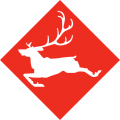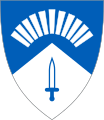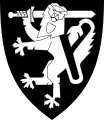6th Division (Norway) facts for kids
Quick facts for kids 6th Division |
|
|---|---|

Insignia of 6th Division until 1991
|
|
| Active | 1897 – 1 August 2009 |
| Country | |
| Branch | |
| Garrison/HQ | Heggelia, Norway |
| Battle honours | World War II |
| Disbanded | 1 August 2009 |
| Commanders | |
| Last Commander | Major general Kjell Grandhagen |
| Notable commanders |
General Carl Gustav Fleischer |
The 6th Division (called 6. divisjon in Norwegian) was a special military group from Norway. It was made up of soldiers and was an important part of Norway's defense for many years. This division was active from 1897 until it was officially closed down on August 1, 2009.
Contents
The 6th Division's Role in World War II
The 6th Division was most important during World War II, especially when Germany invaded Norway. General Carl Gustav Fleischer led this division. He was one of the King of Norway's favorite military leaders.
On April 9, 1940, when the Germans attacked, the 6th Division was one of the few Norwegian groups ready to fight. With help from soldiers from the United Kingdom, France, and Poland, the 6th Division managed to take back the city of Narvik. This event is known as the Battle of Narvik.
The Germans had taken Narvik at the start of the battle. But on May 28, the 6th Division and its allies recaptured it. This was seen as the first big victory for the Allies in World War II. However, the Germans then successfully attacked France. This meant the Allied forces had to leave Norway in June. Because the Allies left, the Norwegian soldiers had to stop fighting and go home.
General Fleischer, the division's commander, later went to Canada. He was given a less important job there. He died in 1942.
After the War: Rebuilding and the Cold War
After the war, the 6th Division was closed down for a short time. But when Norway became free again in 1945, the division was quickly started up once more. The fighting at Narvik led to strong teamwork between the British military and the Norwegian Army. They also worked closely with France's mountain troops.
During the Cold War, which was a period of tension but no direct fighting, the 6th Division did not take part in any wars. By the 1980s, the division had grown. It included several important military areas and brigades. These included Brigade Nord in Tromso, which had about 5,000 soldiers. It also controlled two garrisons, which are military bases, in Finnmark.
After the Cold War ended, the 6th Division was changed in 2002. This was part of a bigger plan to update the entire Norwegian Armed Forces.
How the 6th Division Was Organized
When it was not wartime, the 6th Division had about 1,200 officers and non-commissioned officers (leaders). It also had around 3,000 regular soldiers and 200 civilian workers. If there was a war, the division could grow to more than 12,000 people.
The 6th Division was the only one of its kind in the Norwegian Army. This meant it used many different types of modern fighting equipment. Some of its strongest weapons included:
- Leopard 2A4NO MBTs (Main Battle Tanks), which are very powerful tanks.
- CV9030 IFVs (Infantry Fighting Vehicles), which carry soldiers and have weapons.
- Modernized M109A3GN howitzers, which are large cannons used to fire shells over long distances.
The soldiers who fought on foot used special vehicles. These included Bv206 tracked all-terrain vehicles, snowmobiles, and light off-road vehicles. For moving troops by air, the division used helicopters from the Royal Norwegian Air Force. These helicopters were based at Bardufoss. The division's motto was "Styrke for fred, evne til strid." This means "Strength for peace, capability for war."
Main Units of the 6th Division
The 6th Division included several important smaller units:
- Brigade Nord: This was a brigade of soldiers with vehicles and tanks. It also had artillery units.
- 6th Brigade: This was a reserve brigade made up of light infantry soldiers.
- Army Ranger Command: A special unit for highly trained soldiers.
- Border Guard Battalion: A group that protected Norway's borders.
- Intelligence & EW Battalion: A unit that gathered information and dealt with electronic warfare.
- Home Guard: Even though it was a separate group, all Home Guard areas worked under the 6th Division's command.
The 6th Division also had other support groups. These included engineering units (for building and repairing things) and NBC units (for dealing with nuclear, biological, and chemical threats). The 6th Division was officially closed down on August 1, 2009.
Insignia
The 6th Division used different symbols, or insignia, throughout its history.





